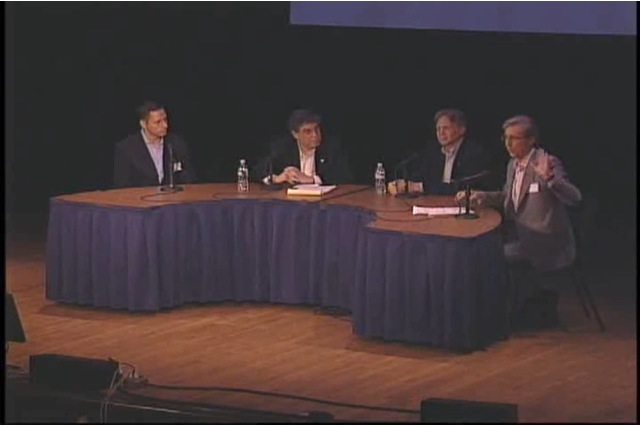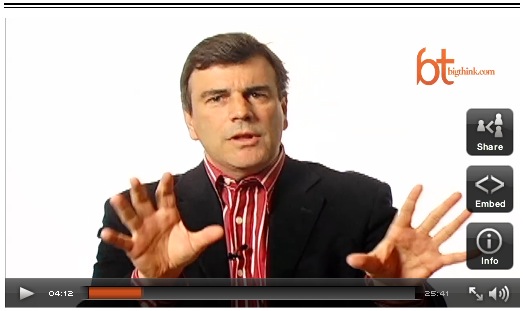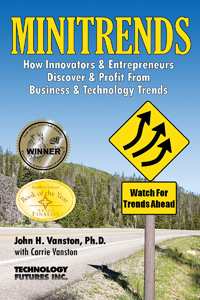InnoTech Conference Teeming With Emerging Trends
October 25, 2011

Sean Lowry, Exe. Dir., Innotech and Carrie Vanston, Co-Author, MINITRENDS at Innotech Conference, Photo by Sloan Foster
I’ve attended the InnoTech Conference and Expo and its associated eMarketing Summit for several years now and always learn a lot. This year I wanted to pass on some comments from experts that I heard yesterday relating to emerging trends that are becoming more and more important:
Sean Lowry, of the very successful InnoTech series, always does a great job of making sure everything runs smoothly. I was even able to steal him for a minute to ask what emerging trends he saw coming. He told me, “I see continued convergence of all the different technologies we are seeing here today. Development of mobile applications and host applications in the cloud are particularly important. There is so much video activity and a lot of it is being hosted in the cloud now.”
I asked Giovanni Galluci, social media expert and Dallas photographer what he thinks the next trend in social media is going to be. He said, “Getting over it. Everyone is burnt out with all the hype and now people are looking for more meaning in social media. Twitter is ridiculous. Those who do marketing are beginning to realize it. Online social media is becoming part of the umbrella of marketing, which is where it belongs. Social media is becoming more commodatized—as in more of a commodity.”
He gave several great hints about Facebook including that Facebook ads are the best way to grow a fan base; Facebook is the 2nd largest search engine, so take advantage of it (including using pictures with metatags, main key words in description, etc.); and put Facebook info on all your printed matter including cards and bills.
I chatted with William Leake, CEO of Apogee Search Marketing, and his take was that “More and more advertising presence is going to be driven by physical location. If you don’t have a physical location strategy, you are going to lose.”
Craig Wax, CEO of Invodo and a video expert, had a lot to say about the future of video marketing. According to Craig, “In the future, no one is going to stand in line anymore. Offline and online is no longer relevant. This is already starting to happen and it is going to become ubiquous.” He added that “QR readers are going to be incorporated into devices and the present obstacles to their use will be chipped away.” (On a side note, Craig was most recently the Senior Vice President and General Manager at Match.com. That had to be an interesting job!)
According to Pat Scherer, Web and Mobile Deployment Manager at The Detail Person, “Mobile space is going to be huge. With the explosion of devices, I think it’s going to make a huge impact on the retail industry. Not only for payments, but for creating local-based experiences utilizing mobile social media. I anticipate this leveling the playing field with e-commerce.”
Finally, I got to chat briefly with siblings Kevin Olsen and Kerri Olsen, Co-Founders of the Austin Grand Prix. Having Formula 1 in Austin exciting!
Cheers,
Carrie Vanston
Media/Marketing Director, Technology Futures, Inc.
Co-Author, MINITRENDS: How Innovators & Entrepreneurs Discover & Profit From Business & Technology Trends
Technology Trends for Entrepreneurs
December 6, 2010

Android-operated microwave oven, from Touch Revolution video.
Entrepreneurs don’t only create new technology trends, they also use them to take care of businesses. One example is the trend away from using in-house journalists to using freelance journalists to using custom content farms.
An example of an entrepreneur who has successfully mined the Minitrend of content farming is Jonathan Blum. Blum has shifted from a career in broadcast journalism, where he worked for MTV and covered the O.J. Simpson trial for ABC News, among other accomplishments, to a career in custom journalism through his award-winning startup, Blumsday.
Blumsday provides custom content for high-end clients, including CNN and TheStreet. His articles are regularly featured in Entrepreneur magazine. His work earned a Best in Business Award from the Society of American Business Editors and Writers.
One of Blum’s recent creations for Business Insider is a list of the top tech trends for entrepreneurs or, as he puts it,
[…] the top 25 tech tips, trends and megatrends: what’s new now, what will be new tomorrow and what you can expect to grapple with even farther down the road.
I would argue that most of these are “minitrends” rather than “megatrends” — that is, trends that show the likelihood of widespread adoption in the next two to five years and are the byproduct of such megatrends as the spread of the Internet, the growth of mobile devices, or the need for alternative energy sources.
The first minitrend I notice is the increasing use of slideshows instead of text to render the forecasts of pundits. Last week, we reviewed the top 10 tech trends of veteran computer journalist Eric Lundquist, who also presented his picks in slideshow format. We also covered Verizon’s top tech trends, which were presented with video — another Minitrend we expect to see more of in the coming years.
Many of the trends on Blum’s list will already be familiar to readers of this blog. Some of the less typical ones include:
- Touch Kiosks — Blum suggests that using inexpensive touchscreens from companies such as HP and Acer can save a bundle in self-serve customer service.
- Server Simplicity — New products combine “phone servers, e-mail servers, routers, document servers and firewalls into a single low-cost device.”
- Smart Boards for Smarter Presentations — BoxLight and Epson make portable smart boards that take presentations way past the PowerPoint.
- Apps for Your Apps — New apps that run on your household appliances, such as washers and dryers, TVs and microwave ovens. No fooling. Check out the Engadget review.
- Automatic Decision-Making — As computers get smarter, they can do more of our work for us. Entrepreneurs look forward to the day when they can ask the computer to find the 20 best venture capital prospects for a business, then return after a coffee break to find a quality list waiting. Blum points to Google’s Aardvark as an early example of an intelligent assistant.
- Virtual Assistant — Using a bot to represent you at meetings, recording what happens and answering questions by accessing all your computer files, may be more than five years away, but it’s still fun to ponder.
Blum has lots of other tips in his presentation — especially for the eco-conscious entrepreneur interested in energy-saving technologies. I recommend you take his presentation for a ride. It’s a quick trip that really delivers do-it-now ideas for entrepreneurs on the go.
STEVE O’KEEFE
News Editor, Minitrends Blog
Source: “The Future-Proof Entrepreneur: 25 New Tech Trends You Need To Know About,” Business Insider, 11/14/10
Source: Blumsday, undated
Image: Screen capture from Touch Revolution video presentation, used under Fair Use: Reporting.
Lundquist: Service Is Top Tech Trend for 2011
December 1, 2010
 December marks the peak season for looking back on trends from the previous year and forward to trends in the coming year. We’d like to start the month at the Minitrends Blog by sharing the forecasts of famous prognosticators in technology trends to see where they are pointing.
December marks the peak season for looking back on trends from the previous year and forward to trends in the coming year. We’d like to start the month at the Minitrends Blog by sharing the forecasts of famous prognosticators in technology trends to see where they are pointing.
First up is Eric Lundquist. Lundquist is a fixture at Ziff Davis Enterprise, where he has ridden the waves of publishing trends as he reports on technology trends. The Harvard-educated scientist began his career as a journalist (you remember what those are, don’t you?), honing his craft as a daily newspaperman. A newspaper is collection of alphabet in ink on paper that was written yesterday, about today, and is worthless tomorrow.
Lundquist joined Ziff Davis back when eWeek was named PC Week, and quickly rose to editor-in chief of that publication. Following his own advice that video is growing as a method of information delivery, Lundquist moved into video production as creator of CIO Insight, a program on The Pulse Network, which combines streaming video with social networking.
In 2009, Lundquist revealed a love-hate relationship in his technology forecast for 2010. Along with the usual suspects (cloud computing, the migration to mobile, etc.), Lundquist expected CIOs to suffer from whiplash as the economy cut their budgets at a time when IT should be growing its budget. He has similar mixed feelings over social networks, seeing them as a growing trend and a growing source of embarrassment for thoughtless executives.
In his new forecast for 2011, the operative word is “service.” Lundquist predicts that most CIOs will have to evaluate and purchase software as a service in 2011. He also sees the rise of “apps” allowing employees to test and choose services rather than the CIO. He sees social networking, tablets, and mobile platforms all working hard to service business and B2B users who need to communicate on closed networks. He concludes his forecast by lauding the Apple Store for its $99/year training service that has created real-world (not virtual) communities of users.
Mixed-in with Lundquist’s predictions for 2011 are some of the usual suspects: the continuing migration to mobile, cloud computing, virtualization, and tablets. Included is his steadfast belief that “video will take a front seat for businesses to provide new product details, showcase executives, and create how-to explanations for their products and services.” Could this be the last time we see Eric Lundquist’s predictions in print? Enjoy the alphabet while you can.
STEVE O’KEEFE
News Editor, Minitrends Blog
Source: “Lundquist’s Top Tech Trends for 2011,” CIO Insight, 11/19/10
Source: “Ten Top Tech Stories of 2009,” CIO Insight, 12/15/09
Source: “CIO Insight,” The Pulse Network
Photo courtesy of fdecomite, used under its Creative Commons license.
Verizon’s Top Tech Trends for 2011: Really Bad Video
November 23, 2010
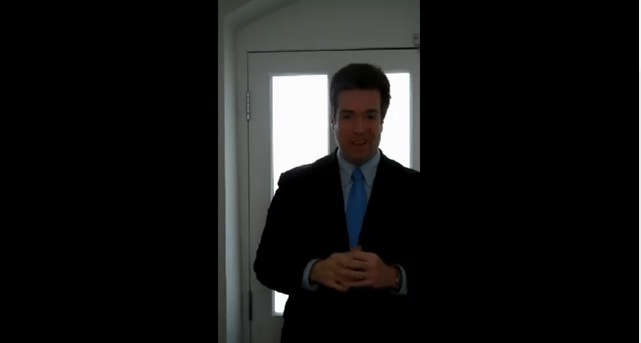
CLICK FOR VIDEO: Screen capture from the video, "Verizon Top 10 Business Technology Trends 2011: Video, the New App Darling"
Verizon just released its predictions for the top technology trends of 2011, and it appears that really bad video is on the list for the new year.
The Verizon top trends list was reported by the popular tech site, CIOL, which is short for CyberMedia India Online Ltd. CIOL provides thumbnail descriptions for each of the 10 trends Verizon forecasts. Here’s the shortlist:
- High-IQ Networks Take Center Stage
- Everything as a Service: a ‘Cloudy’ New Mindset
- Seeing Security Through
- Enterprise Apps Go Mobile
- Video, the New App Darling
- Machine to Machine Cacophony Triggers Transformation
- UC&C Becomes More Than a “Buzz Phrase”
- Farewell to IPv4
- Hello to Universal Identity
- Personalization Inspires Innovation
Number five on that list is “Video, the New App Darling.” About this burgeoning trend, Verizon says in a news release announcing the trends:
Video will be among the most engaging business applications to take advantage of higher-capacity wireless networks for face-to face and face-to-machine interaction… [V]ideo will become an essential tool for workers everywhere.
The problem with this prediction is the video used to deliver it. On the Think Forward Blog, Verizon’s business technology blog, Chris Kimm, Verizon’s vice president of intelligent networking, added a post last Wednesday offering a 10-part video series to introduce Verizon’s Top 10 Technology Trends for 2011. The videos, unfortunately, show what we have to look forward to in the coming video onslaught: Very poorly made videos from people who should know better. Click on the graphic at the top of the post to watch Verizon’s video on the video trend, and see if you can spot these Top-10 Amateur Video Mistakes:
- Uses a low-quality webcam instead of a mini-DV cam or other inexpensive, high-quality digital camera.
- Uses only one third of the visual real estate. Two thirds of the screen is black.
- Uses a built-in microphone rather than a lapel mic or boom mic.
- Terrible audio that makes Kimm sound like he’s at the bottom of a Chilean mineshaft and desperately needs a rescue.
- Looks like he’s in a mineshaft. The narrow but long depth of field creates a tunnel-like visual impression.
- Poor quality backdrop. Even a blank wall would have been better. Has about as much charm as a cheap porn video shot in a Motel 6.
- Horrible backlighting. The backlighting increases the contrast and makes it hard to see Kimm’s facial expressions.
- Doesn’t use directional lights. Even a small, desktop lamp directed toward his face would have made the videos much more watchable.
- Doesn’t use a close-up perspective, which is essential for talking-head videos that are most likely being watched on a small screen, such as a Verizon phone.
- No editing. The videos appear to not have been edited at all. How else to explain the opening and closing moments as a super-close-up Kimm turns on, then off, the camera?
Frankly, these videos make Verizon look like one of the lean solopreneur companies we’ve been talking about on the Minitrends blog — the trend of companies that look big but actually have only one employee and no offices. Isn’t Verizon the company with “The Network” behind it?
My new prediction for top tech trends of 2011: Corporate executives getting some training and equipment for making better impromptu videos.
STEVE O’KEEFE
News Editor, Minitrends Blog
Source: “Top technology trends for 2011: Verizon,” CIOL, 11/18/10
Source: “Cloud Strategies, Economy Continue to Underscore Top Technology Trends for 2011,” Verizon press release, 11/16/10
Source: “Verizon Launches 10-Part Video Series on Technology Trends for 2011,” Verizon Business Think Forward Blog, 11/17/10
Screen capture from Verizon Business video is used under Fair Use: Commentary.
Blackbaud Videos Reveal Trends in Nonprofit Technology
November 15, 2010
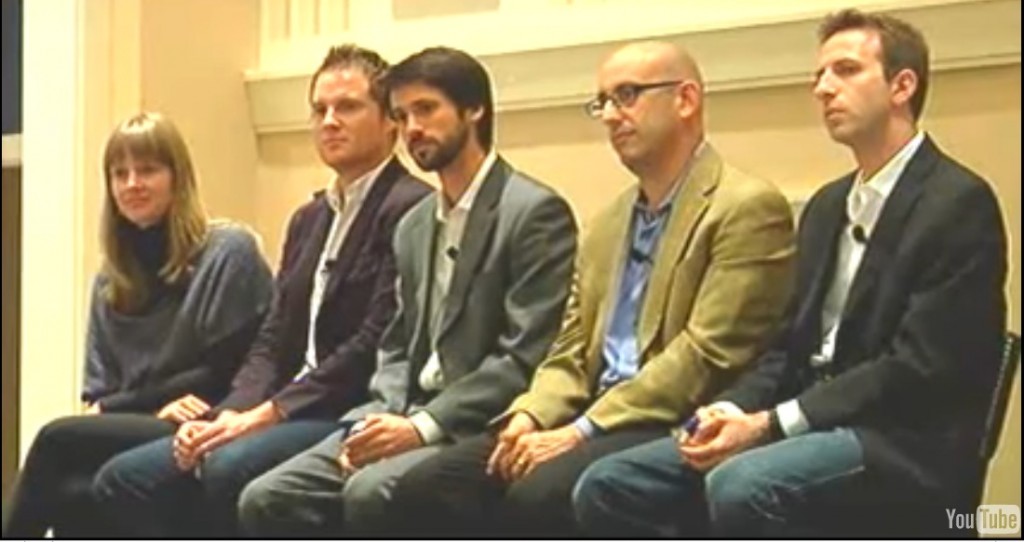
CLICK FOR VIDEO: Panel on Social Media for Nonprofits from the 2010 Blackbaud Conference on Nonprofit Technology
Last week, I broached the topic of how nonprofits are capitalizing on trends in technology to reach constituents through social networking. Today, I’m going to take the discussion up a notch and look at the fountainhead of many tech trends for nonprofits: Blackbaud, Inc.
Blackbaud was founded in 1981 with the purpose of providing technological support to nonprofit organizations. The company’s growth since has been phenomenal. Headquartered in Charleston, South Carolina, Blackbaud now employs more than 2,000 people worldwide. The company went public in 2004 and is traded on the NASDAQ exchange under ticker symbol BLKB.
Shortly after going public, Blackbaud hired Marc Chardon, a former CFO for Microsoft and manager of Microsoft France, as the company’s new president and CEO. Just last week, Blackbaud was named one of Forbes 100 Best Small Companies in America, a ranking based largely on exceptional financial performance.
Blackbaud has become an enormous driver of technology trends in the nonprofit sector. Last month, the company held its annual conference on nonprofit technology, drawing more than 2,200 people to Washington, D.C., for an action-packed program dominated by seminars on social networking.
This month, Blackbaud has made many of these programs available for free viewing on its BlackbaudTV channel on YouTube. These videos are both inspiring and educational for anyone interested in technology trends. Here are some of the highlights:
Global Trends and What They Mean to You
Marc Chardon, President and CEO of Blackbaud
Becoming a Networked Nonprofit: The Road to Effective Use of Social Media
Allison Fine & Beth Kanter, authors of The Networked Nonprofit
Social Media for Nonprofits
Claire Williams Diaz, Social Innovation at Twitter
Noah Everett, Founder of TwitPic
Matthew Mahan, Vice President of Impact at Causes
Geoff Livingston, Co-Founder of Zoetica
Brian Dresher, Mashable (formerly with USA Today)
Social Media: Paint by the Numbers
Holly Ross, Executive Director, NTEN: The Nonprofit Technology Network
The Nonprofit Trust Agent
Chris Brogan, New York Times bestselling co-author of Trust Agents
Most of the videos are an hour long, except for the Chris Brogan interview, which is a five-minute ambush video in the hallway of the conference center. The first video with Marc Chardon is a panel that covers such trends as social media, radical transparency, and the need for nonprofits to demonstrate ROI. The panel on social media for nonprofits is terrific, with presenters limited to five minutes to take their best shots, followed by the audience Q&A.
For access to all the BlackbaudTV videos — including a five-minute interview with Mark Zuckerberg’s engaging and articulate sister, Randi, about five things nonprofits can do to supercharge their Facebook pages — visit the BlackbaudTV page on YouTube.
STEVE O’KEEFE
News Editor, Minitrends Blog
Source: “Blackbaud Conference 2010: 5 Must-See Presentations,” Social Media 4 Nonprofits, 10/24/10
Source: “Reflections from Independent Sector and Blackbaud Conferences,” Beth’s Blog, 10/26/10.
Treasure Trove of Trends in Artificial Intelligence (AI)
November 11, 2010
If you are looking for investors to help your Minitrend Adventure take flight, today’s post has some promising news for you. I’d like to introduce you to three venture capitalists who are looking for you.
- Peter Thiel, co-founder of PayPal and an early investor in Facebook, is looking for startups that are losing money and expect to lose money for a long time to come.
- Mark Gorenberg is managing director of Hummer Winblad Venture Partners and a board member at M.I.T. who is interested in companies that are like two-year-olds: very disruptive, but with a promising future.
- David Rose is a serial entrepreneur and the founder of New York Angels, the largest group of angel investors in New York, and AngelSoft, matchmaking software that pairs projects with funds.
These three venture capital heavyweights came together on a panel at the 2009 Singularity Summit, a conference founded by futurist Ray Kurzweil, investor Peter Thiel, and the Singularity Institute for Artificial Intelligence. The Institute’s mission is to explore the implications of machine intelligence surpassing human intelligence in the near future. If you are new to the concept of “the singularity,” a good place to start is Ray Kurzweil’s provocative bestseller, The Singularity is Near: When Humans Transcend Biology, published in 2006.
The Singularity Summit has been generous, if slow, at putting videos of its conference sessions online, free for all to see. Video from the 2010 summit, held in San Francisco last August, has yet to make it to the Institute’s website. However, one of the nice things about listening to futurists is that even years later, you’re still in time to benefit from their predictions.
In the video referenced above, these three venture capitalists sit down with CNBC host Bob Pisani to talk about trends they are interested in investing in. They identify three interrelated components that excite them about VC pitches:
- Cloud Computing
- Globalization
- Crowdsourcing
The way they see it, cloud computing and related technologies help make possible the globalization of technology which in turn makes possible crowdsourcing, so that many minds representing many perspectives can easily and rapidly help improve whatever process you are pitching. It’s a fascinating triangle of tech that leads to rapid development of disruptive technologies.
The Singularity Summit provides a treasure trove of videos with technological geniuses going back to 2006. Some of the brilliant thinkers you can access through the site include Christine Peterson (Foresight Nanotech Institute), Aubrey de Grey (Methuselah Foundation), Peter Norvig (Google), Peter Voss (Adaptive AI), Sam Adams (IBM), Esther Dyson (ICANN), and dozens more.
Exploring these video archives will help you quickly hone in on Minitrends which have the greatest promise for development in the coming three-to-five years. They can also help you locate the people who can assist you with both technology and money. As both Peter Thiel and David Rose describe in the video, successful venture capital is often about putting the right people together so they don’t have personality conflicts that derail their promising projects.
There’s one other trend you can glean from this video — a fashion trend. VCs don’t wear ties. Sometimes it comes down to those little things when you’re on the hunt for big money. Good luck!
STEVE O’KEEFE
News Editor, Minitrends Blog
Source: “Venture Capitalist Panel at Singularity Summit 2009,” Singularity Institute, 11/04/09
Source: Singularity Interviews 2006-2009, Singularity Institute for Artificial Intelligence.
Michael Schrage on Looking Sharp in Cyberspace
October 7, 2010
- The Big Think Interview with Michael Schrage
One of my favorite technology bloggers is Sloan School of Management fellow, Michael Schrage, who does a weekly post at the Harvard Business Review. As I’ve mentioned before, one of the great things about being a futurist is being able to see into the future. I have seen, for example, that Michael Schrage will have a new book on “rapid innovation” out next April.
Schrage is cited as a source of inspiration in the section of MINITRENDS dealing with “New Approaches to Giving and Receiving Advice.” Technology has made it possible for remote consulting services to be delivered in ever-improving packages. In a blog post in April, Michael Schrage imagines a new service that makes you look better in video chat. He writes:
Telecommuters might quite happily pay good money out of their own pockets for software that lets them look terrific on broadband without having to shave or put on makeup. Apple could do quite well with branded ‘iLookBetter’ apps to improve one’s videoconference aesthetic.
I have noticed recently that the NBC Nightly News has started to use Skype interviews in its telecasts. With Skype, any executive can conduct a videochat with any news organization from any hotspot with a laptop or a G3 phone with a Skype app.
Just because you can chat this way doesn’t mean you should. In a recent post on the SixEstate blog, I spotted a TV interview with a Silicon Valley CEO who was Skyping from his hotel room in bad light with an unmade bed in the background. Very unprofessional.
Schrage pleads with videochat makers to at least let people see themselves before they go live, so they can see how bad they look and take appropriate action. Until the instant digital makeover is invented, here are some tips for giving better presentations using videochat:
- Use a video camera instead of your computer’s built-in camera. Even small, hand-held cameras can be put on a mini-tripod and hooked into your laptop for far superior image quality.
- The cool fluorescent lights often found in offices make people look blue and ashen in video chat. Consider replacing those with warm fluorescent lightbulbs for a more natural glow.
- Get a cheap clamp-lamp and a spendy “true light” lightbulb, such as the Reveal lightbulb made by GE, and keep them in your travel bag. Clamp the light onto your laptop and turn it on before video chatting. You’ll be amazed by how much better you look.
- Create a good backdrop for your video chats. Book cases are classic. I keep a stylish curtain nearby that I can quickly drape behind me for a solid background.
- Preview yourself before you go live. In Skype, you can preview yourself in the Preferences under Video Preferences.
Take these simple precautions, and you’ll look better than all of the other folks using built-in cameras and available light. For the entrepreneurs out there, how about some help building better office or home studio setups for those of us dispensing advice remotely? If you know of any tips, tricks, or apps for better videoconferencing, we invite you to share them in the comments.
STEVE O’KEEFE
News Editor, Minitrends Blog
Source and Image: “The Big Think Interview with Michael Schrage,” BigThink, 04/05/10
Source: “Why Your Looks Will Matter More, Thanks to the Internet,” Harvard Business Review Blogs, 04/22/10
